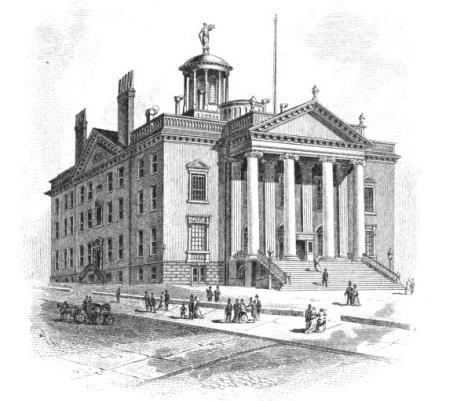Members 32 Members 126 | ||
 | ||
Term July 1, 1818 – June 30, 1819 President Lt. Gov. John Tayler (Dem.-Rep.) | ||
The 42nd New York State Legislature, consisting of the New York State Senate and the New York State Assembly, met from January 5 to April 13, 1819, during the second year of DeWitt Clinton's governorship, in Albany.
Contents
Background
Under the provisions of the New York Constitution of 1777, amended by the Constitutional Convention of 1801, 32 Senators were elected on general tickets in the four senatorial districts for four-year terms. They were divided into four classes, and every year eight Senate seats came up for election. Assemblymen were elected countywide on general tickets to a one-year term, the whole Assembly being renewed annually.
In 1797, Albany was declared the State capital, and all subsequent Legislatures have been meeting there ever since. In 1818, the Legislature enacted that future Legislatures meet on the first Tuesday of January of each year unless called earlier by the governor.
In 1816, Hamilton County was split from Montgomery County, but both remained together in one Assembly district. Also in 1816, Oswego County was formed from parts of Oneida and Onondaga counties, and Oswego and Oneida remained together in one Assembly district.
In 1818, Joseph Ellicott resigned from the Erie Canal Commission, due to ill health. On June 18, during the recess of the Legislature, Gov. DeWitt Clinton appointed State Senator Ephraim Hart to fill the vacancy temporarily.
At this time the politicians were divided into two opposing political parties: the Federalists and the Democratic-Republicans. The Democratic-Republican Party was split into two factions: the Clintonians (supporters of Gov. DeWitt Clinton and his Erie Canal project) and the Bucktails (led by Att. Gen. Martin Van Buren, and including the Tammany Hall organization in New York City).
Elections
The State election was held from April 28 to 30, 1818. Senators Darius Crosby (Southern D.) and William Ross (Middle D.) were re-elected. Moses Austin (Middle D.), Levi Adams (Eastern D.), Perry G. Childs, David E. Evans (both Western D.), and Assemblymen George Rosecrantz (Eastern D.) and Gamaliel H. Barstow (Western D.) were also elected to the Senate.
Sessions
The Legislature met at the Old State Capitol in Albany on January 5, 1819, and adjourned on April 13.
On January 4, a Democratic-Republican Assembly caucus met to nominate a candidate for Speaker. 75 members attended, including almost all Bucktails elected, but 10 to 15 Clintonians had not arrived yet. William Thompson (Bucktail) received 42 votes, Obadiah German (Clintonian) 33. The Clintonians refused to "make the nomination unanimous", and refused to support Thompson in the Assembly on the next day.
On January 5, the Assembly met and took four ballots for Speaker without anybody receiving a majority, and adjourned.
On January 6, the vote on the fifth ballot stood: German 55, Thompson 38, William A. Duer (Fed.) 20. Then Erastus Root offered a resolution that Thompson be appointed Speaker which was lost with a vote of 41 to 73. Then a resolution was offered that Duer be appointed Speaker which was lost too, with a vote of 31 to 84. Then a resolution was offered that German be appointed Speaker which was adopted with a vote of 67 to 48.
The refusal of the Clintonians to support the caucus nominee for Speaker led to the permanent split of the New York Democratic-Republicans into Clintonians and Bucktails. The last time both factions caucused together was when a candidate for U.S. Senator was to be nominated, and the meeting broke up after much mutual verbal abuse without having had any ballot. At the same time, the Federalists were split into a Pro-Clinton majority (led by Thomas J. Oakley) and an Anti-Clinton minority (led by William A. Duer).
On February 7, the Legislature failed to elect a successor for U.S. Senator Rufus King (Fed.) and the seat became vacant on March 4. The vote stood: in the Senate, State Senator Samuel Young (Buckt.) 13, Congressman John C. Spencer (Clint.) 10 and the incumbent King 4; in the Assembly, Spencer 51, Young 43 and King 28.
On February 8, Erastus Root (Buckt.) offered a resolution for the call of a State "Convention with unlimited powers to revise, alter or modify the Constitution." After much debate, this resolution was rejected, like a similar one during the previous session, but the issue was pursued further by the Bucktails, and led to the New York State Constitutional Convention of 1821, and a new Constitution.
On March 24, the Legislature rejected the recess appointment of Ephraim Hart (Clint.) as Erie Canal Commissioner, and elected State Senator Henry Seymour (Buckt.) to fill the vacancy caused by the resignation of Joseph Ellicott. Seymour was chosen by joint ballot of the Legislature with a majority of a single vote. This gave the Bucktails a majority of 3 to 2 in the Commission, and instead of opposing the Canal project itself, the Bucktails now—the construction being well under way—supported it, for both political and financial reasons.
Districts
Members
The asterisk (*) denotes members of the previous Legislature who continued in office as members of this Legislature. George Rosecrantz and Gamaliel H. Barstow changed from the Assembly to the Senate.
Employees
Assemblymen
The asterisk (*) denotes members of the previous Legislature who continued as members of this Legislature.
